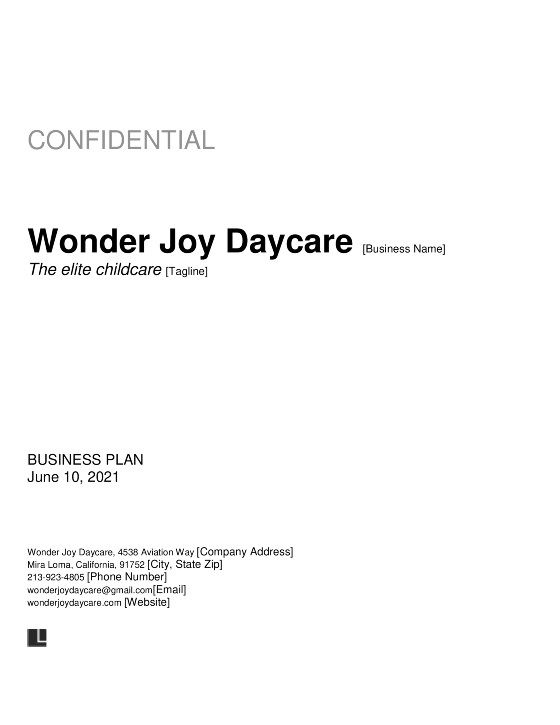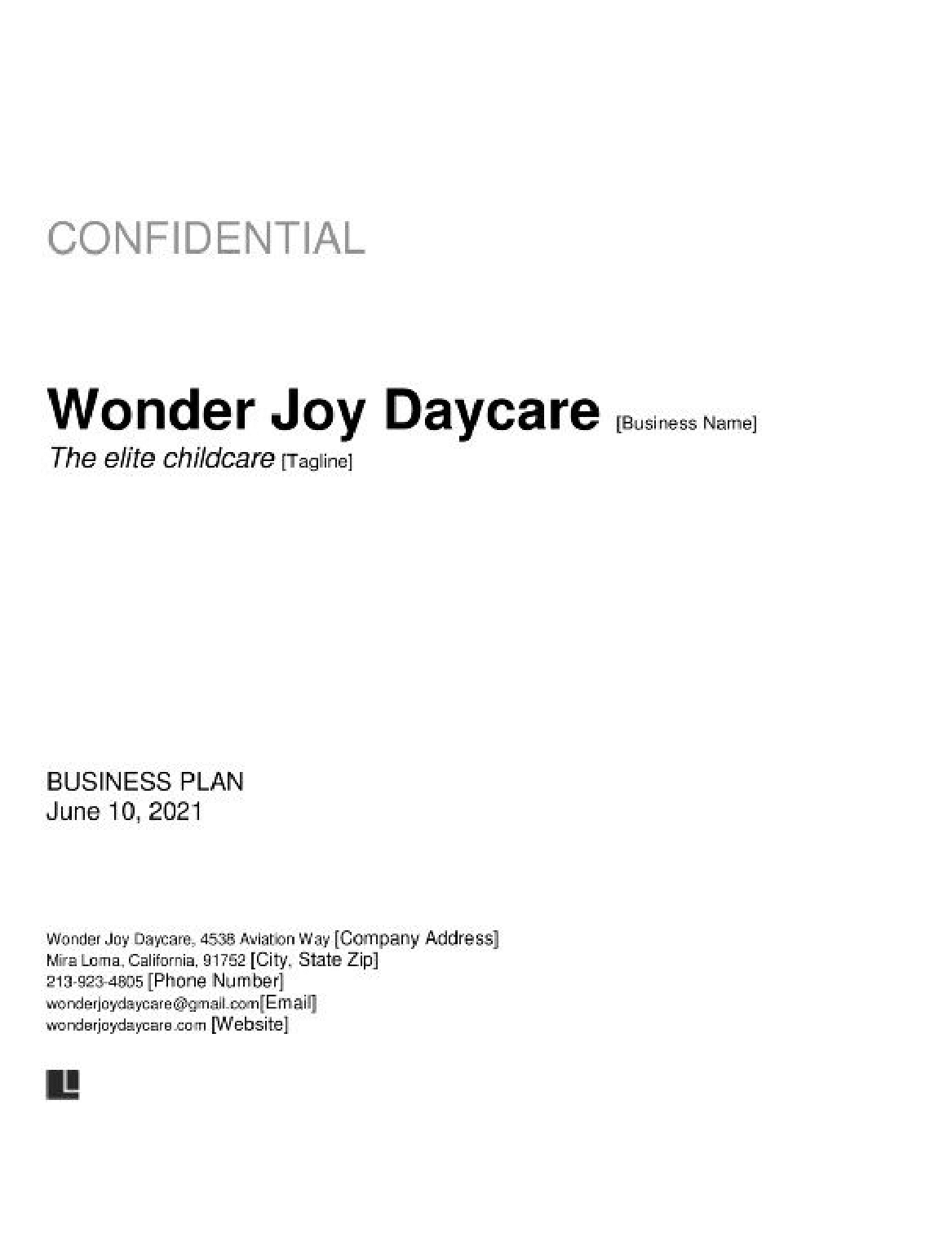When you are ready to start a daycare business, you need an effective plan outlining how to get there. High-quality child care is in high demand, but you must be prepared for the challenges of starting a new business.
A solid business plan will get you off on the right foot before you even open the doors of your new facility.
With these helpful tips, you can learn how to make a business plan for a daycare center. Whether you are looking to watch over young children or even need a dog daycare business plan, Legal Templates is here to help you get started.
Why You Need a Business Plan for Your Daycare Business
A business plan sets the stage for how you will operate your business and how you will get it running. A daycare is no different. Opening a daycare requires intensive planning, legal compliance, and understanding of your market.
A daycare business plan template walks you through the steps to build a proper path forward. Every successful business is planned correctly, not as you go along.
A sample daycare business plan pdf or Word document lays it out for you. You can learn how to put it together and what you must include. Many business plans help you understand what you must do to prepare.
Some are designed to recruit potential investors to your cause. Either way, you need a business plan to prepare you for the challenges and successes ahead.

How to Write a Business Plan for a Daycare
Knowing how to write your daycare business plan can be tricky without some help. You may not have done this before, but a daycare business plan example can help.
Follow these writing tips in each section to create a strong business plan for your future daycare.
1. Executive Summary
The initial section of your business plan is the executive summary. This part of your plan is an introduction for whoever reads it. It is designed to offer an overview of the remaining sections. It should be concise and add only summary details—this is not the section for intensive information or data.
The executive summary will highlight what your daycare business will look like and the most crucial section of your entire plan.
This section may provide information such as:
- A business address
- Phone number, email address, and other contact information
- List of owners
- Banking information
- Start date for the daycare
- Client base
- Market niche
- Factors for success
The executive summary lets you make a case for why your particular daycare will be successful and competitive. It is also the section that helps you sell yourself and your business to potential investors who may play a critical role in starting your daycare.
Provide a mission statement that reflects your goals for the daycare and your motivation for starting your business.
2. Management Team
Your daycare business plan should include important information about your management team. The first part of this section may address ownership of the business itself. It should outline all essential ownership details, such as:
- Legal names of every owner
- Each owner’s proportionate share
- The format of ownership percentage (i.e., stocks, capital investments, etc.)
- The format of the business (Corporation, LLC, etc.)
- Contact information for each owner
You want everyone who reads this business plan to know who has a stake and how their interests are represented. These details are a crucial part of business formation and preventing costly legal disputes in the future.
The management team section should also include the profiles of your management staff. These people will run the business daily, and they should be properly vetted before being put in charge.
Your business plan should list the management teams’:
- Names and positions
- Summary of responsibilities
- Credentials and education background
- Prior employment or experience
- Early childhood education licensing or other credentialing
- Management experience
- Salary and benefits
- Past success in a similar role
This information should demonstrate why these are the right people for the job. Not only does it help you know how your business will run, but it also shows others you have a proper plan in place for your daycare.
3. Products and Services
This section lets you talk about why you are starting this business in the first place. You will outline the services or products you intend to sell to consumers. For a daycare, it should outline the following:
- Who is being cared for: Children, elderly adults, or pets?
- Business hours
- Staff costs and required credentials
- Will you offer food, diapers, and other child-care products?
- How will you measure sales metrics
Daycare is typically considered a service, but product sales are also often a part of this model. Your plan should adequately account for how you will handle this dual purpose and how it fits into your business model.
4. Customers and Marketing
You must identify your market and how you will get customers into your daycare. This section will focus on your area’s need for daycare services and the types of customers you expect to get.
Identification of customers is a vital part of a business plan and should include details like:
- How many parents need childcare services?
- What costs can families be expected to pay for your services
- The community you will target
- Demographic data for potential customers
With your customers in mind, you can focus on your marketing strategies. You want to differentiate yourself from competitors and ensure the community knows your new business. The daycare business plan must outline how you will achieve these goals.
A marketing strategy should combine both traditional and digital marketing methods, including:
- Open houses
- Word-of-mouth advertising
- Advertisements in the paper or yellow pages
- Billboards or other ads
- Television, radio, or internet advertisements
- A website
- Social media pages
5. SWOT Analysis
A SWOT analysis will address your daycare’s strengths, weaknesses, opportunities, and potential threats. This analytical method examines your company and how it will operate.
It puts each of the four metrics into a visual matrix to help prospective business owners quickly identify favorable and unfavorable factors that may affect their business venture.
A SWOT analysis should focus on how your daycare services can perform against competitors. It may address factors like:
- Any threats the daycare may face
- Competitive advantages and why they would be successful
- Areas that may be improved over time
- Technology or resources the company may use to increase efficiency
- Internal factors that may affect economic success
Detailed SWOT sections show investors you have done your homework and give you valuable data to make informed business choices.
6. Financials
A business plan should address the unique financial situation you face. Your daycare business plan should demonstrate your break-even amounts and expected profit margins.
It will also address the costs and the areas of revenue you expect. You will want to address the following:
- Enrollment fees
- Payment plans
- Cost of supplies and materials
- Employee costs
- Regulatory costs
- Additional program offerings and revenue
- Necessary loans or capital improvements
A well-developed budget can demonstrate expected cash flows versus expected expenditures. Knowing how to handle these costs will be incredibly helpful in starting your daycare.
7. Operations
Your operational plan should outline specific procedures your business and staff will follow. It will list employees and those in management positions and their responsibilities.
As in your management section, a detailed “chain of command” is essential. Staff are an important part of your operations and should be detailed here.
One of the most important aspects of a daycare operation is its location. It would be best if you addressed the following:
- The facility’s address
- The type of area it is in (residential, commercial)
- The space available and amenities
- Why is it a prime location
- Accessibility to the community for drop-off
You should also list your business hours and the services you will have available at different times. Child daycare centers differ in when they offer care—whether during the day, evenings, or even on weekends.
If you are doing other forms of daycare, you may even utilize late or overnight hours. You can decide how you run your business, but operations should be clearly outlined in your business plan.
8. Appendix
The appendix section allows you to include other documents that add to your business plan. They may include legal documents like licensing credentials, insurance information, and business formation documents.
Additional documents in this area are meant to support your business plan. The appendix might also include the following:
- Reference letters
- Permits
- Photographs of the facility, locations, or general area
- Market research data
- Compliance Requirements
The appendix is a flexible section that lets you add supporting documents and other relevant information. Only add details that are helpful to your business plan. The appendix does not need to be lengthy or filled with fluff.
Daycare Business Plan Sample
Legal Templates has the daycare business plan sample you need to construct your plan. With this sample at your disposal, you can formulate a business plan for your daycare to show to investors or for your purposes.
You may also use a business plan builder template to help you construct your daycare business plan step by step. See the sample below to help you get started.


